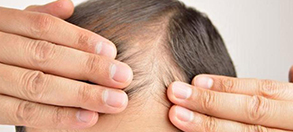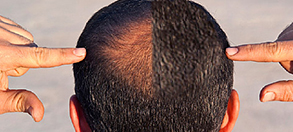Learning how female hair restoration can reverse hair loss is important for improving hair growth and density. Hair loss can result in bald spots or a receding hairline that can affect your confidence, appearance, and self-esteem. With innovative female hair restoration procedures, hair loss products, and services, we can improve your hair quality and density without lengthy downtimes or long surgical scars. There is no need to let hair loss continue to affect your appearance and self-esteem!
At Houston Hair Transplant Center (HHTC), we specialize in customizable hair restoration procedures and techniques for women that we personalize for your hair, needs, and goals. Dr. Goran Jezic has helped numerous female patients improve their hair growth for thicker, fuller hair and natural-looking results.
Contact our Houston office or call (713) 864-2300 to schedule a consultation and begin your hair restoration treatment today!
Female Hair Restoration Treatments
Female hair restoration treatments can address hair loss that occurs from a variety of different conditions. Hair loss in women is commonly due to factors like genetics, autoimmune conditions, medications, anxiety, menopause, hormonal imbalance, pregnancy, and anemia. Female pattern hair loss (FPHL) affects approximately 40% of women by age 30. (1) Androgenic alopecia–a genetic condition that results in thin hair, bald patches, and a receding hairline–affects approximately 27% of women during their lives. Bald spots and/or a receding hairline can be difficult to conceal and often significantly impact one’s self-esteem. (2) With female hair transplants and non-surgical hair restoration for women, we can address the areas where you are experiencing hair loss using hair transplants or minimally invasive techniques that do not require lengthy downtime. Hair loss can even affect the eyebrows.
Follicular Unit Extraction (FUE)
With follicular unit extraction (FUE), we can take healthy hair follicles from one area of the scalp and place them in an area where you are experiencing hair loss, such as your hairline. Unlike an older hair transplant technique known as Follicular Unit Transplantation (FUT), the FUE procedure does not require a long linear scar or a long recovery. FUE is minimally invasive and customizable, so we can strategically address the areas where you are experiencing thinning hair. If you have large areas experiencing hair loss, mega-session FUE can transfer a larger number of hair follicles up to 4,000 grafts during a single procedure.
ATERA
ATERA FUE is a technology that harvests and extracts your hair follicles with advanced lubricating technology. The machine moisturizes the hair follicles to improve the hair grafting process, making it easier for the hair follicles to take root. With a lightweight handpiece, the team will extract the donor hairs with a gentle suction that does not damage the surrounding tissue, allowing for minimal recovery time. The grafts are kept lubricated throughout the process to preserve their integrity and to prevent them from drying and dying.
NeoGraft
NeoGraft is a hair transplant technology that extracts the hair follicles individually with semi-automated technology for efficient grafting. It harvests the hair follicles with gentle suction.
Follicular Unit Transplant (FUT)
For our female patients, FUT is presented as an option as it lowers the transection rate, which could be a challenge for female hair in an FUE procedure. FUT involves taking a linear strip behind the ears or from the back of the head, which is then dissected into individual grafts that are implanted into the thinning and balding areas.
Hybrid Hair Restoration
A hybrid hair restoration procedure addresses hair loss with multiple hair restoration techniques, including hair transplants and non-surgical hair restoration, during a single procedure for natural-looking results. If you are experiencing thinning hair or bald spots, we can rejuvenate your appearance by using the best techniques to address different concerns.
Topical Treatments
Depending on your type of hair loss, we can recommend topical scalp treatments to support your follicles and promote healthy hair growth. Minoxidil (Rogaine) increases your circulation, which can improve hair growth. We can also improve your hair transplants with topical treatments, and the combined therapy can help you address multiple concerns.
Injections
Dr. Jezic can also administer injectable treatments that harness the power of your blood to address hair loss. He can extract plasma from a sample of your blood and administer it directly to the scalp to improve your hair growth. The nutrient-rich serum increases the growth factors on your scalp, stimulating the follicles for improved hair growth. (3) Supporting your scalp and improving the structure of your hair follicles can help you enjoy natural-looking results and denser, fuller hair. This treatment also increases the number of fibroblasts in your scalp to reduce inflammation. (4,5) Fibroblasts help your skin produce collagen and elastin (proteins that help your skin maintain its structure and elasticity).
Other procedures include cellular micrografting using the European Regenera Activa technology, which enables the harvesting of up to 50 hair follicles to process them and extract stromal vascular fraction (SVF), an autologous (derived from your own tissue) cellular solution that is injected into your thinning and balding areas.
To learn more, see our blog.
Benefits
There are several benefits to female hair restoration procedures, including:
- Minimally invasive therapy: Our clinical team can extract the follicles with gentle suction to preserve the surrounding tissue without large incisions for minimal recovery.
- Natural-looking results: After FUE, the hair follicles take root for natural-looking results, so you can enjoy lasting hair growth.
- Long-lasting hair growth: If you take good care of your scalp by using preventive maintenance topicals and products, you can enjoy consistent hair growth.
- Comfortable treatment: Most procedures are performed under topical or local anesthesia and do not involve scarring.
- Minimal recovery: Although you must avoid excessive sun exposure and be gentle with your scalp, these treatments require minimal downtime.
- Customizable treatment: We can personalize your treatment and perform multiple types of hair transplants (FUT, FUE, or Hybrid) in a single procedure for the best results.
Candidates & Consultation
Suitable candidates would like to address the following:
- Thinning hair or bald spots
- Hair loss
- Thinning hair
- Bald patches
- Compromised hairline.
To receive hair restoration treatments and procedures, you must have realistic expectations about what the treatment can achieve and have enough donor hair for the transplant. During your consultation, we can examine where you are losing hair and discuss the best treatment plan for your needs. We may recommend changing your routines that regularly involve wearing tight hairstyles that pull on your hair.
Do not wait to schedule a consultation and learn how female hair restoration can improve your appearance and help you address hair loss with long-lasting results.
How to Prepare for a Female Hair Transplant
To prepare for female hair transplants, you will need to:
- The doctor may advise you to stop taking blood-thinning medications and supplements a week or so before and after your procedure. However, do not stop any medications without the consent and approval of your physician.
- Refrain from smoking for several weeks before and after (if applicable).
- Stop drinking alcohol 24 to 72 hours before and after your procedure.
You will need to eat a light breakfast on the day of your procedure and get adequate sleep the night before (7-8 hours). Many patients also ask a trusted friend to drive them home afterward and arrange a few days off work to help their bodies heal.
After a Female Hair Transplant
Following a hair transplant procedure, you will need to be gentle with your scalp. We can recommend at-home treatment plans to help you optimize your healing. We will also provide aftercare instructions to help you take good care of yourself. Eating nutritious foods and exercising can help support hair growth, and wearing gentle hairstyles that do not pull on your scalp can help you enjoy long-lasting results. If you take good care of your scalp, you can enjoy denser, consistent hair growth and a natural-looking appearance.
The Cost of Female Hair Restoration in Houston, Texas
The cost of female hair restoration depends on the type of procedure you receive and whether you need additional treatments to achieve your aesthetic goals. We can provide an all-inclusive quote for your treatment after discussing your goals at your consultation. Schedule your consultation today or call our Houston office at (713) 864-2300 to learn more!
FAQ
What causes hair loss in women?
Hair loss can result from several different factors, including genetics, health conditions, medications, menopause, pregnancy, stress, hormonal imbalance, and tight hairstyles.
Are hair transplants permanent?
Hair transplants are long-lasting if you take good care of your scalp, but your results will depend on your genetics and medical history.
How long does the recovery from female hair restoration last?
You can return to most of your normal activities after a few days, but it can take time for hair to grow. After a few months, you can see the full effect when the follicles have had time to take root.
Can I combine female hair transplants with other treatments?
Yes, you can combine the treatment with several other hair loss therapies, depending on your needs and the type of hair loss you are experiencing.
Will I have scarring from a female hair transplant?
An FUE hair transplant should not cause linear scarring or scalp irritation. Non-surgical hair restoration treatments do not cause scarring. The treatment harnesses the hair follicles with gentle suction for natural-looking, long-lasting results.
References
- Famenini S, Slaught C, Duan L, Goh C. Demographics of women with female pattern hair loss and the effectiveness of spironolactone therapy. Journal of the American Academy of Dermatology. 2015;73(4):705-706. doi:https://doi.org/10.1016/j.jaad.2015.06.063
- Kische, Hanna, et al. “Sex Hormones and Hair Loss in Men from the General Population of Northeastern Germany.” JAMA Dermatology, vol. 153, no. 9, 1 Sept. 2017, p. 935, https://doi.org/10.1001/jamadermatol.2017.0297. Accessed 29 Mar. 2020.
- Lin W, Xiang LJ, Shi HX, et al. Fibroblast Growth Factors Stimulate Hair Growth throughβ-Catenin and Shh Expression in C57BL/6 Mice. BioMed Research International. 2015;2015:1-9. doi:https://doi.org/10.1155/2015/730139
- Cheng M, Ma C, Chen HD, Wu Y, Xu XG. The Roles of Exosomes in Regulating Hair Follicle Growth. Clinical, Cosmetic and Investigational Dermatology. 2024;17:1603-1612. doi:https://doi.org/10.2147/CCID.S465963
- Gupta AK, Wang T, Rapaport JA. Systematic review of exosome treatment in hair restoration: Preliminary evidence, safety, and future directions. Journal of Cosmetic Dermatology. 2023;22(9):2424-2433. doi:https://doi.org/10.1111/jocd.15869



